AMD's Radeon HD 5870: Bringing About the Next Generation Of GPUs
by Ryan Smith on September 23, 2009 9:00 AM EST- Posted in
- GPUs
Power, Temperature, & Noise
As we have mentioned previously, one of AMD’s big design goals for the 5800 series was to get the idle power load significantly lower than that of the 4800 series. Officially the 4870 does 90W, the 4890 60W, and the 5870 should do 27W.
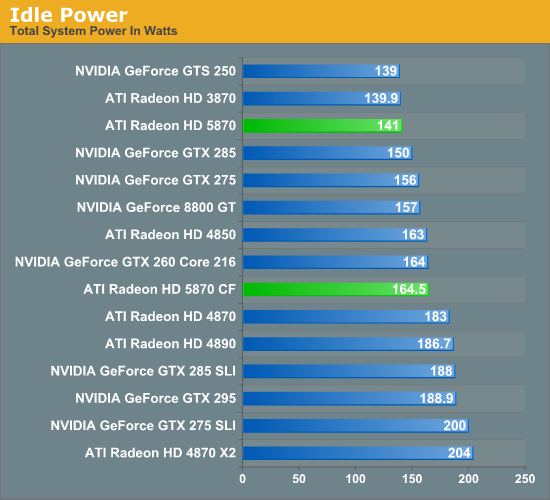
On our test bench, the idle power load of the system comes in at 141W, a good 42W lower than either the 4870 or 4890. The difference is even more pronounced when compared to the multi-GPU cards that the 5870 competes with performance wise, with the gap opening up to as much as 63W when compared to the 4870X2. In fact the only cards that the 5870 can’t beat are some of the slowest cards we have: the GTS 250 and the Radeon HD 3870.
As for the 5870 CF, we see AMD’s CF-specific power savings in play here. They told us they can get the second card down to 20W, and on our rig the power consumption of adding a second card is 23.5W, which after taking power inefficiencies into account is right on the dot.
Moving on to load power, we are using the latest version of the OCCT stress testing tool, as we have found that it creates the largest load out of any of the games and programs we have. As we stated in our look at Cypress’ power capabilities, OCCT is being actively throttled by AMD’s drivers on the 4000 and 3000 series hardware. So while this is the largest load we can generate on those cards, it’s not quite the largest load they could ever experience. For the 5000 series, any throttling would be done by the GPU’s own sensors, and only if the VRMs start to overload.
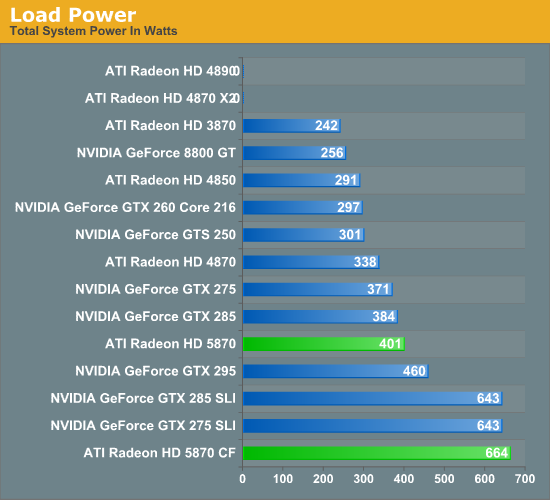
In spite of AMD’s throttling of the 4000 series, right off the bat we have two failures. Our 4870X2 and 4890 both crash the moment OCCT starts. If you ever wanted proof as to why AMD needed to move to hardware based overcurrent protection, you will get no better example of that than here.
For the cards that don’t fail the test, the 5870 ends up being the most power-hungry single-GPU card, at 401W total system power. This puts it slightly ahead of the GTX 285, and well, well behind any of the dual-GPU cards or configurations we are testing. Meanwhile the 5870 CF takes the cake, beating every other configuration for a load power of 664W. If we haven’t mentioned this already we will now: if you want to run multiple 5870s, you’re going to need a good power supply.
Ultimately with the throttling of OCCT it’s difficult to make accurate predictions about all possible cases. But from our tests with it, it looks like it’s fair to say that the 5870 has the capability to be a slightly bigger power hog than any previous single-GPU card.
In light of our results with OCCT, we have also taken load power results for our suite of cards when running World of Warcraft. As it’s not a stress-tester it should produce results more in line with what power consumption will look like with a regular game.

Right off the bat, system power consumption is significantly lower. The biggest power hogs are the are the GTX 285 and GTX 285 SLI for single and dual-GPU configurations respectively. The bulk of the lineup is the same in terms of what cards consume more power, but the 5870 has moved down the ladder, coming in behind the GTX 275 and ahead of the 4870.
Next up we have card temperatures, measured using the on-board sensors of the card. With a good cooler, lower idle power consumption should lead to lower idle temperatures.
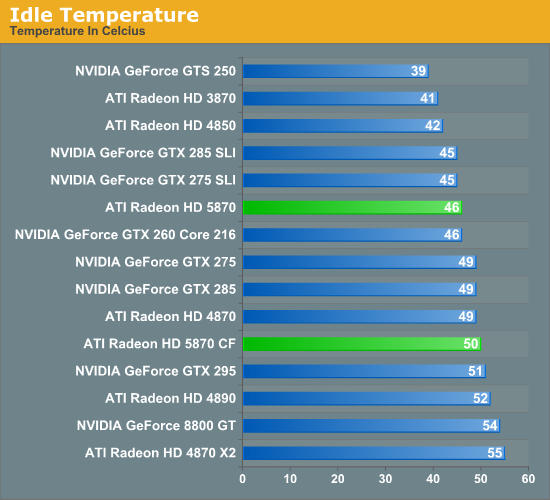
The floor for a good cooler looks to be about 40C, with the GTS 250, 3870, and 4850 all turning in temperatures around here. For the 5870, it comes in at 46C, which is enough to beat the 4870 and the NVIDIA GTX lineup.
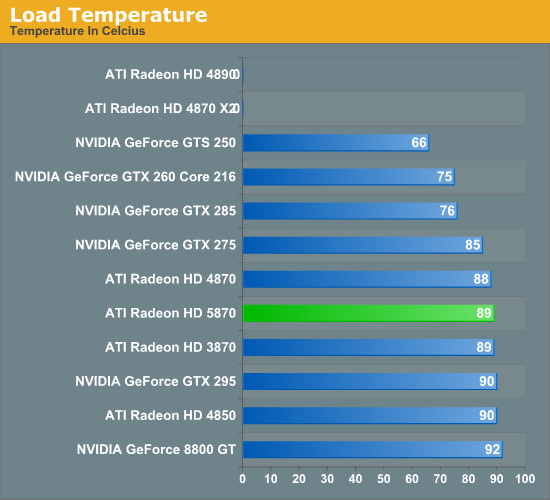
Unlike power consumption, load temperatures are all over the place. All of the AMD cards approach 90C, while NVIDIA’s cards are between 92C for an old 8800GT, and a relatively chilly 75C for the GTX 260. As far as the 5870 is concerned, this is solid proof that the half-slot exhaust vent isn’t going to cause any issues with cooling.
Finally we have fan noise, as measured 6” from the card. The noise floor for our setup is 40.4 dB.

All of the cards, save the GTX 295, generate practically the same amount of noise when idling. Given the lower energy consumption of the 5870 when idling, we had been expecting it to end up a bit quieter, but this was not to be.
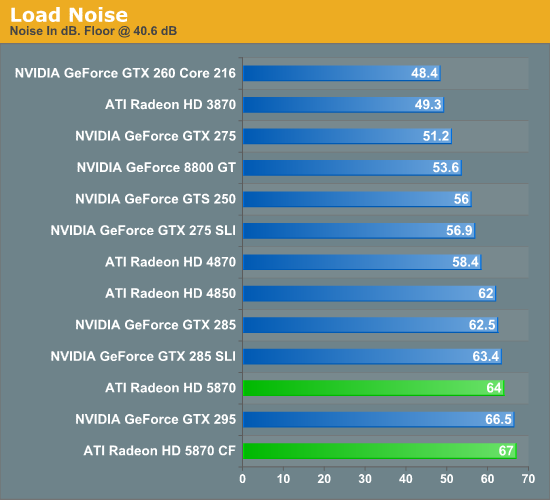
At load, the picture changes entirely. The more powerful the card the louder it tends to get, and the 5870 is no exception. At 64 dB it’s louder than everything other than the GTX 295 and a pair of 5870s. Hopefully this is something that the card manufacturers can improve on later on with custom coolers, as while 64 dB at 6" is not egregious it’s still an unwelcome increase in fan noise.










327 Comments
View All Comments
SiliconDoc - Monday, September 28, 2009 - link
When the GTX295 still beats the latest ati card, your wish probably won't come true. Not only that, ati's own 4870x2 just recently here promoted as the best value, is a slap in it's face.It's rather difficult to believe all those crossfire promoting red ravers suddenly getting a different religion...
Then we have the no DX11 released yet, and the big, big problem...
NO 5870'S IN THE CHANNELS, reports are it's runs hot and the drivers are beta problematic.
---
So, celebrating a red revolution of market share - is only your smart aleck fantasy for now.
LOL - Awwww...
silverblue - Monday, September 28, 2009 - link
It's nearly as fast as a dual GPU solution. I'd say that was impressive.DirectX 11 comes out in less than a month... hardly a wait. It's not as if the card won't do DX9/10.
Hot card? Designed to be that way. If it was a real issue they'd have made the exhaust larger.
Beta problematic drivers? Most ATI launches seem to go that way. They'll be fixed soon enough.
SiliconDoc - Monday, September 28, 2009 - link
Gee, I thought the red rooster said nvidia sales will be low for a while, and I pointed out why they won't be, and you, well you just couldn'r handle that.I'd say a 60.96% increase in a nex gen gpu is "impressive", and that's what Nvidia did just this last time with GT200.
http://www.anandtech.com/video/showdoc.aspx?i=3334...">http://www.anandtech.com/video/showdoc.aspx?i=3334...
--
BTW - the 4870 to 4890 move had an additional 3M core transistors, and we were told by you and yours that was not a "rebrand".
BUT - the G80 move to G92 added 73M core transistors, and you couldn't stop shrieking "rebrand".
---
nearly as fast= second best
DX11 in a month = not now and too early
hot card -= IT'S OK JUST CLAIM ATI PLANNED ON IT BEING HOT !ROFL, IT'S OK TO LIE ABOUT IT IN REVIEWS, TOO ! COCKA DOODLE DOOO!
beta drivers = ALL ATI LAUNCHES GO THAT WAY, NOT "MOST"
----
Now, you can tell smart aleck this is a paper launch like the 4870, the 4770, and now this 5870 and no 5850, becuase....
"YOU'LL PUT YOUR HEAD IN THE SAND AND SCREAM IN CAPS BECAUSE THAT'S HOW YOU ROLL IN RED ROOSERVILLE ! "
(thanks for the composition Jared, it looks just as good here as when you add it to my posts, for "convenience" of course)
ClownPuncher - Monday, September 28, 2009 - link
It would be awesome if you were to stop posting altogether.SiliconDoc - Monday, September 28, 2009 - link
It would be awesome if this 5870 was 60.96% better than the last ati card, but it isn't.JarredWalton - Monday, September 28, 2009 - link
But the 5870 *is* up to 65% faster than the 4890 in the tested games. If you were to compare the GTX 280 to the 9800 GX2, it also wasn't 60% faster. In fact, 9800 GX2 beat the GTX 280 in four out of seven tested games, tied it in one, and only trailed in two games: Enemy Territory (by 13%) and Oblivion (by 3%), making ETQW the only substantial win for the GT200.So we're biased while you're the beacon of impartiality, I suppose, since you didn't intentionally make a comparison similar to comparing apples with cantaloupes. Comparing ATI's new card to their last dual-GPU solution is the way to go, but NVIDIA gets special treatment and we only compare it with their single GPU solution.
If you want the full numbers:
1) On average, the 5870 is 30% faster than the 4890 at 1680x1050, 35% faster at 1920x1200, and 45% faster at 2560x1600.
2) Note that the margin goes *up* as resolution increases, indicating the major bottleneck is not memory bandwidth at anything but 2560x1600 on the 5870.
3) Based on the old article you linked, GTX 280 was on average 5% slower than 9800X2 and 59% faster than the 9800 GTX - the 9800X2 was 6.4% faster than the GTX 280 in the tested titles.
4) Making the same comparisons, 5870 is only 3.4% faster than the 4870X2 in the tested games and 45% faster than the 4890HD.
Now, the games used for testing are completely different, so we have to throw that out. DoW2 is a huge bonus in favor of the 5870 and it scales relatively poorly with CF, hurting the X2. But you're still trying to paint a picture of the 5870 as a terrible disappointment when in fact we could say it essentially equals what NVIDIA did with the GTX 280.
On average, at 2560x1600, if NVIDIA's GT300 were to come out and be 60% faster than the GTX 285, it will beat ATI's 5870 by about 15%. If it's the same price, it's the clear choice... if you're willing to wait a month or two. That's several "ifs" for what amounts to splitting hairs. There is no current game that won't run well on the HD 5870 at 2560x1600, and I suspect that will hold true of the GT300 as well.
(FWIW, Crysis: Warhead is as bad as it gets, and dropping 4xAA will boost performance by at least 25%. It's an outlier, just like Crysis, since the higher settings are too much for anything but the fastest hardware. "High" settings are more than sufficient.)
SiliconDoc - Tuesday, September 29, 2009 - link
In other words, even with your best fudging and whining about games and all the rest, you can't even bring it with all the lies from the 15-30 percent people are claiming up to 60.96%--
Yes, as I thought.
zshift - Thursday, September 24, 2009 - link
My thoughts exactly ;)I knew the 5870 was gonna be great based on the design philosophy that AMD/ATi had with the 4870, but I never thought I'd see anything this impressive. LESS power, with MORE power! (pun intended), and DOUBLE the speed, at that!
Funny thing is, I was actually considering an Nvidia gpu when I saw how impressive PhysX was on Batman AA. But I think I would rather have near double the frame rates compared to seeing extra paper fluffing around here and there (though the scenes with the scarecrow are downright amazing). I'll just have to wait and see how the GT300 series does, seeing as I can't afford any of this right now (but boy, oh boy, is that upgrade bug itching like it never has before).
SiliconDoc - Thursday, September 24, 2009 - link
Fine, but performance per dollar is on the very low end, often the lowest of all the cards. That's why it was omitted here.http://www.techpowerup.com/reviews/ATI/Radeon_HD_5...">http://www.techpowerup.com/reviews/ATI/Radeon_HD_5...
THE LOWEST overall, or darn near it.
erple2 - Friday, September 25, 2009 - link
So what you're saying then is that everyone should buy the 9500 GT and ignore everything else? If that's the most important thing to you, then clearly, that's what you mean.I think that the performance per dollar metrics that are shown are misleading at best and terrible at worst. It does not take into account that any frame rates significantly above your monitor refresh are for all intents and purposes wasted, and any frame rates significantly below 30 should by heavily weighted negatively. I haven't seen how techpowerup does their "performance per dollar" or how (if at all) they weight the FPS numbers in the dollar category.
SLI/Crossfire has always been a lose-lose in the "performance per dollar" category. Curiously, I don't see any of the nvidia SLI cards listed (other than the 295).
That sounds like biased "reporting" on your part.